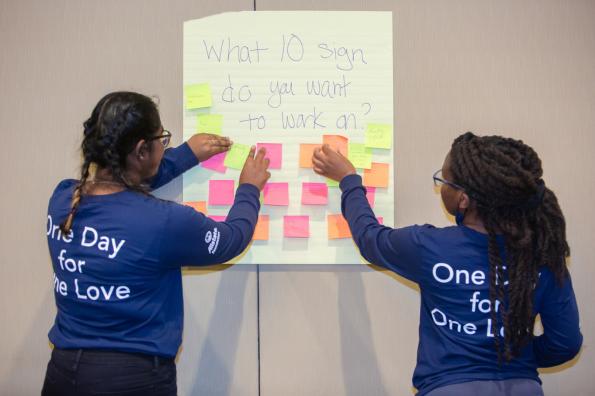![]() Written by One Love Writers Corp member, Stephanie Perez
Written by One Love Writers Corp member, Stephanie Perez
Suicide. It’s a word often whispered, if mentioned at all. It’s a topic that many people are afraid or ashamed to talk about openly, which is why it is so great to see how pop-culture is helping to raise awareness on this issue. Suicide has been featured prominently lately, in shows such as Netflix’s “13 Reasons Why,” and in music, such as Logic’s powerful suicide prevention anthem “1-800-273-8255.” This shift in cultural attention couldn’t have happened at a better time because suicide is on the rise. Suicide is a significant problem in the United States. Each year nearly 43,000 Americans die by suicide. One American dies by suicide every 12.3 minutes! It is a public health problem that does not discriminate, affecting people of all ages, races, genders, and socioeconomic status. Yet, despite the magnitude of the problem, there is still a lot of stigma and shame surrounding the topics of suicide and mental health. Together, we can help raise awareness and connect those who are struggling with suicidal thoughts with the necessary resources.
Did You Know…?
- Suicide is the 10th leading cause of death in the U.S., and the 2nd leading cause of death among people ages 10-24.
- More teenagers and young adults die from suicide than from cancer, heart disease, AIDS, birth defects, stroke, pneumonia, influenza, and chronic lung disease COMBINED.
Relationship Abuse and Suicide

![]() Survivors of relationship abuse are particularly vulnerable when it comes to suicide risk. Although there is no single cause for suicide, there is a clear link between relationship abuse and suicide, with survivors of relationship abuse twice as likely to attempt suicide as individuals who have not experienced abuse. Relationship abuse, whether it is sexual, physical or emotional, can lead to various psychological consequences such as anxiety, depression, Post-Traumatic Stress Disorder, and can also lead to social isolation – all factors that can increase a person’s risk of suicide.
Survivors of relationship abuse are particularly vulnerable when it comes to suicide risk. Although there is no single cause for suicide, there is a clear link between relationship abuse and suicide, with survivors of relationship abuse twice as likely to attempt suicide as individuals who have not experienced abuse. Relationship abuse, whether it is sexual, physical or emotional, can lead to various psychological consequences such as anxiety, depression, Post-Traumatic Stress Disorder, and can also lead to social isolation – all factors that can increase a person’s risk of suicide.
What You Can Do
Suicide, like relationship abuse, is highly stigmatized. The most powerful way to remove that stigma is to raise awareness and openly discuss mental health. Also, since relationship abuse significantly raises a person’s risk of suicide, another way to help is learning the difference between healthy and unhealthy relationships. Check out the 10 Signs of a Healthy Relationship and the 10 Signs of an Unhealthy Relationship to learn more. Knowing the difference is the first step to protect yourself or a loved one from an unhealthy relationship.
Be a Lifeline and Save a Life

If you have a friend or a family member who may be suicidal, here are five action steps recommended by the National Suicide Prevention Lifeline that you can take:
- Ask: Don’t be afraid to ask a person directly if they are having suicidal thoughts. By asking them directly, you are signaling to that person that you are open to discussing it in a compassionate, supportive, and non-judgmental way.
- Keep them Safe: After asking and determining that the person is indeed contemplating suicide, it’s important to take steps to keep them safe. Asking them if they have already attempted harming themselves, or if they have a specific, detailed plan, can help you assess the severity of the situation and take the necessary actions to help that person.
- Be There: You can be there for a person in different ways; you can physically be there with them, or you can call or text to keep connected with them. Being there for someone who is suicidal can be life-saving because it increases their sense of connectedness and limits their isolation, both important factors in lowering a person’s risk for suicide. In other words, let them know they are not alone and that someone loves them!
- Help Them Connect: Connect the person with ongoing support that can help them establish a safety net when they find themselves in crisis, such as the National Suicide Prevention Lifeline. You can also help the person develop a safety plan, which includes a plan for what they can do when experiencing a crisis, and a list of people to contact if they find themselves in a crisis. My3app is an excellent safety planning tool that you can share with a friend or family member.
- Follow Up: After connecting the person with the appropriate support, check up on them. A call, a text, or even a handwritten note can go a long way in showing you care. This type of contact helps to increase the person’s feelings of connectedness and helps them feel supported and cared for.
Together we can help remove the stigma and save a life.
Additional Resources:
National Suicide Prevention Lifeline: 1-800-273-8255
Text Crisis Text Line a free 24/7 text line at 741-741
American Association of Suicidology: www.suicidology.org
American Foundation for Suicide Prevention: www.afsp.org
Browse by Category

How To Talk To A Friend In An Unhealthy Relationship
It’s not easy to know how to talk to a friend when we’re worried they’re in an unhealthy relationship. We…
How to Practice Allyship Using the 10 Signs
During the month of June the United States observes both…
Hope After Abuse: What I Wish I Knew About Relationships In College
As a freshman in college – my first real time…
A Crash Course In Handling Rejection
The spring/summer cusp is an exciting time of year: long…
6 Ways to Reconnect with Yourself When You Feel Lost in Your Relationship
Do you feel that you completely lose yourself when you…














